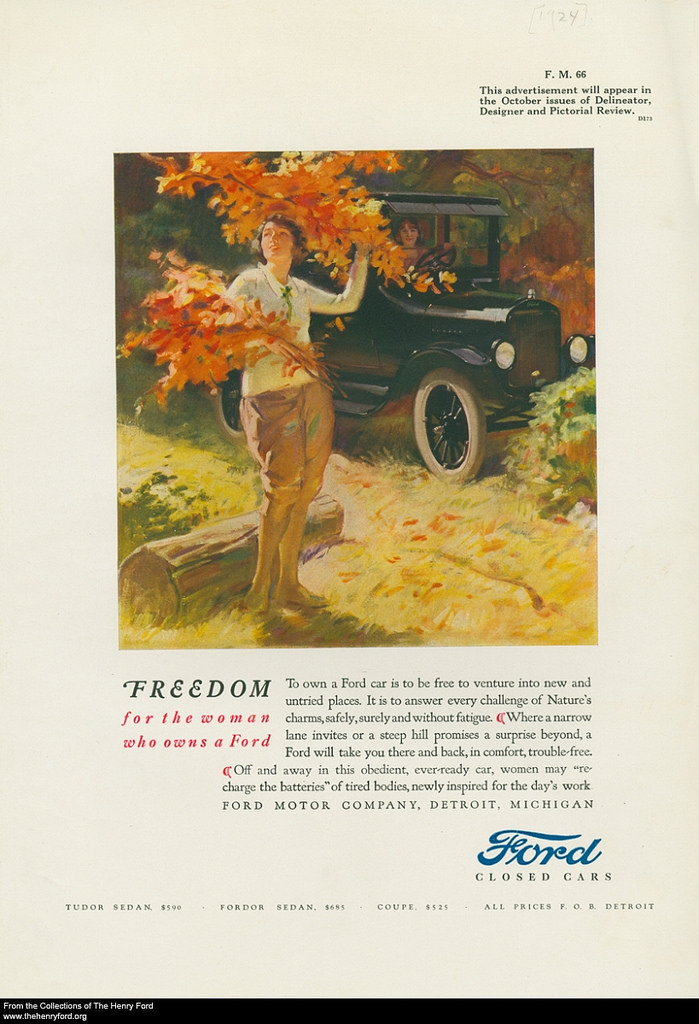
What patterns can we see in this complicated story?
- the modern era was a change not just in way of life
but in worldview
- pattern by which a revolutionary new technology
comes into use
- initial reaction of skepticism, earliest version of the technology isn't very impressive
- fear of new technologies, fear of change in way of
life, though this is less than it was in earlier times
- at first it isn't clear which version of the
technology will be successful
- in the modern era people get more comfortable with
breaking tradition--on average but some groups resist
- impact of technology on society
- but also the impact of society on technology
What is freedom? word cloud
We use technology to express our values
- the ideology of individual autonomy (or family
autonomy)
- independence
- privacy
- freedom of motion
- private ownership
- symbol that an individual can become anything he or she wants
- feel in control
- "no one can tell me what to do"
- efficiency
- sense of community
- national pride
in Germany the automobile is less a symbol of autonomy and more a symbol of quality, people want the best performing automobile
values shape consumer choices and therefore which technologies succeed
The modern dream changed from the giant city to the suburbs as a result of the spread of the automobile. Americans valued freedom of movement.
the automobile was revolutionary compared to the the railroad because it allowed individualized travel
notice the experimenting with different ideas of what an automobile should be before one wins out
before that there was the horse and carriage
- carriages weren't common until the 18th century even in Europe because roads weren't good enough
- early colonial roads were cleared paths that quickly became rutted, not to mention the problem of mud
- if you wanted to transport a heavy load in New England you waited until winter and used a sleigh
- the most characteristic carriage in the U.S. was the American buggy--lightweight practical vehicles
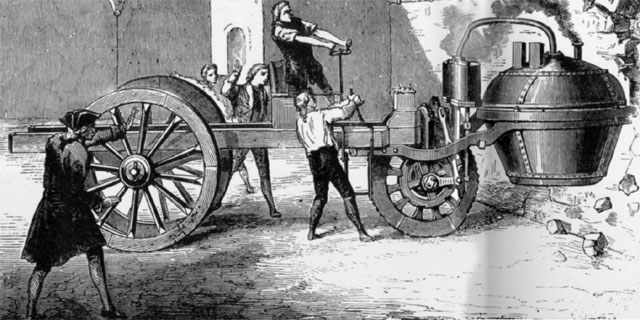
- A French artillery officer, Nicholas Joseph Cugnot, built and ran a 3 wheeled carriage powered by a steam engine in 1769, but which ran off the road the first time it went into a curve at its full speed--3 miles an hour. It was the first self-propelled highway vehicle, but it was no improvement over the horse.
- Some steam powered busses were actually used commercially in England in the first half of the 19th century, but once the railroad took off it was clearly superior.
- The railroad and stagecoach industries succeeded in having a law passed to stop these in 1865 (repealed 1896)--on the ground of the dangers of frightening horses self-propelled vehicles on public highways were limited to a speed of 4 miles an hour and had to be preceded by a man on foot carrying a red flag
- An internal combustion engine burns the fuel inside
the engine (as different from a steam engine)--usually
uses gasoline
- Etienne Lenoir (a Belgian mechanic working in Paris) developed a workable two cycle internal combustion engine in 1860, but it weighed several hundred pounds and developed 2 horsepower. He actually built and ran a vehicle using his engine, but it was an isolated experiment that didn't lead to anything.
- Nicholas Otto did better with a four stroke engine, and a number of German inventors immediately wanted to put it in a road vehicle. Gottlieb Daimler and Wilhelm Maybach and Karl Benz built the first workable vehicles with one cylinder engines (first a motorcycle and a tricycle) and developed workable automobiles in the 1880s and had them in commercial production in the early 1890s. Significant commercial production developed in the 1890s in Germany and France (whose advantage was good roads), with Britain trying to catch up. These were mostly playthings for wealthy sportsmen, though by 1900 touring cars were used some by wealthy families instead of carriages and there was some use of electric automobiles by wealthy ladies in the city.
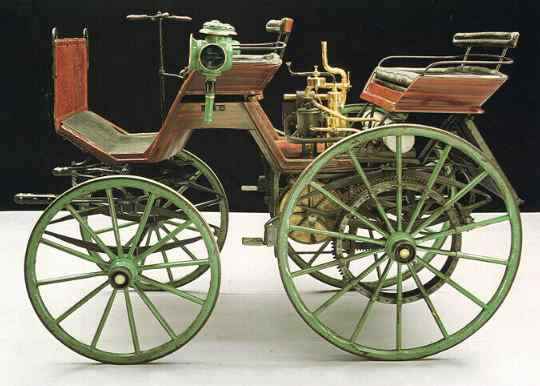
Daimler 1886
- J. K. Starley introduced the safety bicycle in 1885. People had been satisfied with the railroad--only with the bicycle did they think of long-distance travel over ordinary roads. Freedom to travel where you wanted.
- the pneumatic tire was invented by John Dunlop in Ireland in 1888 specifically for use in bicycles
- the automobile would not have been able to compete with the railroad in comfort and speed without the hard-surface road and the pneumatic tire
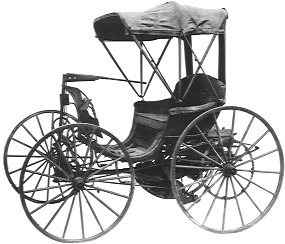
1893 Duryea
- George Selden filed
for a patent on an internal combustion engine and four
wheel car in the U.S. in 1879 but he was a patent lawyer
and realized that his patent would run out too soon to
make money so he filed a series of amendments so the
patent was not granted until 1895. Automobile
makers had to pay him royalties until Ford won a
court case against Selden's patent in 1911
- The first workable American automobile was developed by two brothers who were bicycle mechanics, Charles and Frank Duryea, who copied a published description (Scientific American, 1889) of Benz's automobile and built a motor car with a one cylinder engine in 1893. Others quickly followed--the Chicago Times Herald sponsored the first American automobile race in 1895, which was won by Frank Duryea who covered a 55 mile course at an average speed of 8 miles an hour with a two cylinder automobile
- enthusiasm for the
automobile led to a lot of very amateur
re-inventing. Hiram
Percy Maxim, son of the inventor of the Maxim gun
and an MIT graduate, claimed he had the idea for a
powered vehicle when he was bicycling home late one
night after a romantic evening. He knew that
internal-combustion engines existed and might provide
the mechanism he wanted, but he had never seen one, so
he went to see a natural-gas powered Otto engine working
a pump. He did not know if gasoline could be used
as a fuel--he was completely unaware of what had been
done in Europe and by the Duryea brothers. So he
took himself to a remote corner of the land of the
American Projectile Company where he worked with a half
a pint of gasoline and some empty cartridge cases to
find out what happened when gasoline was ignited in a
cylinder. He was lucky and didn't kill himself,
but it took him 3 years to develop a workable
engine. His results attracted the attention of the
Pope Bicycle Company and he went to Hartford to be chief
engineer of Pope's attempt to establish the first
large-scale commercial production of automobiles.
Unfortunately Colonel Albert A. Pope thought people the
gasoline engine was too dangerous ("You can't get people
to sit over an explosion.") and in two years the company
build 500 electric and 40 gasoline carriages.
Maxim went on to pioneer amateur radio.
- in the 1890s the technological choice was not clear, and gasoline, electric and steam cars were built in close to equal numbers. The electric was actually most popular at first, because it was silent, clean, and easy to operate, but battery technology did not allow long runs and high speeds. The early steam cars had more power than gasoline cars and did not require complicated transmissions, but high pressure steam engines required a lot of maintenance, a lot of water, and raised public fears of boiler explosions
- most of the early manufacturers bought parts from suppliers and assembled automobiles one by one--they were not much concerned with improvements of the parts (the part-makers generally had licensed the key technology)
- production rose rapidly
- by 1899 30 companies were producing vehicles commercially and had produced about 2500 vehicles--many were sold through bicycle dealers. In 1900 production was 4,192 units sold for an average price of just over $1000 each.
- in 1908--the year the Model T was born and General Motors was founded, production had risen to 65,000.
- By 1910 458,500 automobiles were registered in the United States, made by something over 1000 different manufacturers
- and a whole range of
motorcycles as well
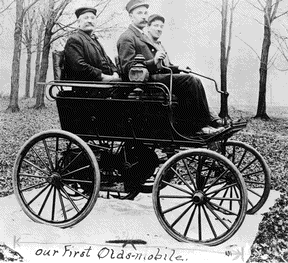
- some manufacturers build cars like carriages--fairly heavy (with a lot of wood) touring cars that were often owned by well-to-do families and driven by chauffeurs who handled the maintenance of the car. Studebaker had been the largest manufacturer of horse-drawn vehicles in the world before turning to automobiles.
- other manufacturers imitated the mass production of bicycles--produced a standardized light-weight, low-price automobile. Ford was not the originator of this approach, but rather invented an improved method of mass production. Pope had been a bicycle maker, Pierce-Arrow started out making bird cages, then spokes for bicycle wheels, then complete bicycles and motorcycles, then automobiles. Ransom Olds designed an early low-priced car in 1899 and produced them in large numbers--5,000 in 1904--before deciding to concentrate on touring cars. It wasn't quite an early Model T--it was too small, too light, and too low powered for family transportation. Role of “tinkerers” and technology transfer
Henry
Ford

Ford's beginnings (Ford biography)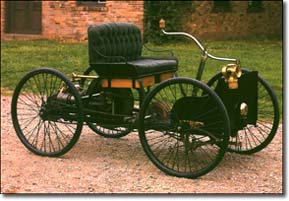
Ford's Quadricycle
Struggle to define the automobile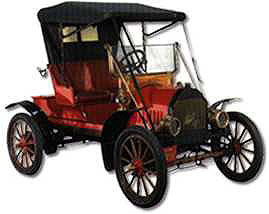
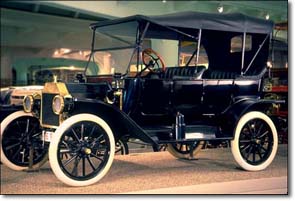
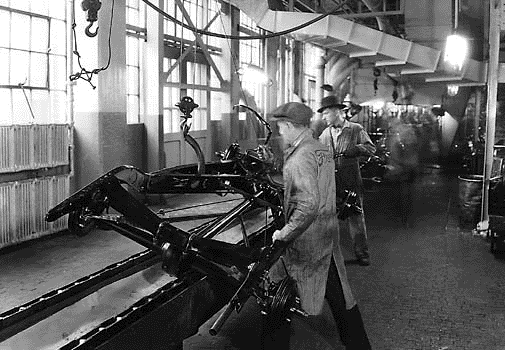
Ford assembly line and Diego Rivera painting (Detroit Institute of Arts)
Model T Automobile Plant
Meanwhile Sloan at General Motors was revolutionizing organization and marketing
1927 Chevrolet
Lienhard points to automobile racing and luxury automobiles as showing important ways that automobile technology went in different directions from the practical car predicted by Henry Ford:

Ford's beginnings (Ford biography)
- son of a Dearborn farmer, but with a talent for mechanics that led him to a series of engineering jobs before he got into automobiles
- In 1896 Ford was chief engineer of the Edison Illuminating Co. (now Detroit Edison).
- In that year he built a car called the Quadricycle and started looking for backers to produce it commercially (he later claimed to have built a car in 1892 but there is no evidence for that but Ford's claims).

Ford's Quadricycle
- in 1899 he found a group of businessmen to support him, but they got impatient that he was building cars for automobile racing (which he thought was critical publicity) rather than concentrating on setting up commercial production. Ford and his backers parted ways in 1902 and his former backers found another engineer, Henry M. Leland, who gave the company a new name--Cadillac--and got it into commercial production.
- Racing was a way to test out which car
was better and get publicity, but it didn't lead to
practical cars
Struggle to define the automobile

- Ford started the Ford Motor Company in
1903 with a new set of backers.
- The Dodge brothers became stockholders in return for providing chassis, engines, and transmissions for the first Ford cars.
- Ford initially made medium-priced cars--$1000-$1500.
- by 1910 the industry was consolidating painfully
- General Motors was about to go under under excessive debt and was saved only by new investors who advanced cash on very harsh terms (6% interest plus a 17% commission).
- many of the smaller companies went bankrupt, and even the larger ones were better at finance than at solving technological problems.
- a number of makers were thinking about low cost cars (an idea that was not tried in Europe until after its success in America). One notable example after the curved dash Oldsmobile was the Brush Runabout, which sold for $500 and had 10 HP and all-wood construction. It didn't hold up very well.
- the key invention of this period was
the electric starter
- It was invented by Henry M. Leland and Charles F. Kettering. Leland became interested in the problem because a friend of his had died in a bizarre accident. He went to the assistance of a lady whose car had stalled, and when he turned the crank to start it, the crank handle kicked back and broke his jaw. He died of the resulting gangrene.
- the electric starter meant that women and older men could drive cars
Ford first invents a better car, then leads assembly-line revolution (more on Ford as a businessman)
- Ford first designed a mass market car
and then studied how to cut costs in production.
Mass market meant not only low cost but sturdy, easy
to operate, and easy to repair. Ford was one of
the first to use alloy steel in America.
Ford's engineers may have had the idea for the assembly line as early as 1908, but they didn't want to delay introduction of the model T to implement it. The Model T was the first low cost ($825-$850) high power (20 HP) car, also light (about 1,200 pounds) and fairly easy to drive, with a two-speed, foot-controlled "planetary" transmission. It was immediately very popular--compared to cars costing $2000. Ford decided in 1909 to produce nothing else.

- Ford's business manager had calculated that to really hit the mass market the price had to be brought down to $600, and that could not be done with existing production methods.
- Ford begins to focus on how his
company can build this car cheaper--look for economies
of scale
- between 1913 and 1914 conveyor belts were introduced throughout the factory
- time required to assemble the chassis fell from 12 hours 30 minutes to 2 hours 40 minutes, and then by 1914 to 1 1/2 hours
- price of Model T dropped to $360 by 1916 and to $290 by 1927 (its last year of production). 577,000 sold in 1916. Within a decade all automobile manufacturers were using the assembly line.
- in addition to the assembly line Ford
lowers costs by economies of scale and vertical
integration

Ford assembly line and Diego Rivera painting (Detroit Institute of Arts)
- now Ford could hire unskilled workers
- He paid average wages: $2.38 for a nine hour day. Workers hated the assembly line and turnover reached over 300%
- in 1914 Ford began to offer selected workers $5 a day and an eight hour day--about twice the going rate in Detroit at the time. At one point fire hoses had to be used to disperse the mob of applicants around the Highland Park plant.
- Between 1914 and 1916, the company's profits doubled from $30 million to $60 million.
- Ford did believe that the gains made by improving techniques of production should be passed on to society in three ways--to stockholders through dividends, to consumers through lower prices, and to labor through higher wages. He understood that the worker was also a consumer. He wasn't fond of stockholders, particularly after the Dodge brothers set themselves up as competitors. In fact in 1916 (a year with record profits) he paid such low dividends that stockholders sued and won. Ford quotes

Model T Automobile Plant
Meanwhile Sloan at General Motors was revolutionizing organization and marketing
- gave more responsibility to production divisions--decentralized organization
- General Motors made cars for different markets (from Chevrolet at the bottom to Cadillac at the top) and pioneered the annual model change and a choice of colors. Worked out close relations with dealers. Consumers began to look for styling and excitement, not the lowest possible price.
- Ford made the Model T until 1927--15 million of them--nearly driving the company into bankruptcy. Finally when he had to face reality and shut down Model T production he didn't have a new model designed yet.
- Even then he played the publicity well
and the new Model A was a success.

1927 Chevrolet
Lienhard points to automobile racing and luxury automobiles as showing important ways that automobile technology went in different directions from the practical car predicted by Henry Ford:
"The automobile
delivered its conflicting messages of personal freedom,
populism, luxury, economy, speed, and general excess."
(p. 136)